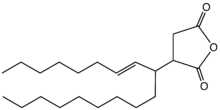Succinic anhydride
 | |
| Names | |
|---|---|
| Preferred IUPAC name
Oxolane-2,5-dione[1] | |
| Other names
3,4-Dihydrofuran-2,5-dione, Butanedioic anhydride[1] Dihydrofuran-2,5-dione Succinic acid anhydride Succinyl oxide Dihydro-2,5-furandione | |
| Identifiers | |
| 3D model (JSmol) |
|
| ChEBI | |
| ChemSpider | |
| ECHA InfoCard | 100.003.246 |
| KEGG | |
| PubChem CID |
|
| UNII | |
| |
| |
| Properties | |
| C4H4O3 | |
| Molar mass | 100.07 g·mol−1 |
| Appearance | Colorless crystalline needles[2] |
| Density | 1.23 g/cm3[2] |
| Melting point | 119 to 120 °C (246 to 248 °F; 392 to 393 K)[3] |
| Boiling point | 261 °C (502 °F; 534 K)[2] |
| Decomposes | |
| -47.5·10−6 cm3/mol | |
| Hazards | |
| Flash point | 147 °C (297 °F; 420 K)[4] |
| Lethal dose or concentration (LD, LC): | |
| LD50 (median dose) |
1510 mg/kg (oral, rat)[4] |
| Except where otherwise noted, data are given for materials in their standard state (at 25 °C [77 °F], 100 kPa). | |
| | |
| Infobox references | |
Succinic anhydride, is an organic compound with the molecular formula (CH2CO)2O. This colorless solid is the acid anhydride of succinic acid.
Preparation
In the laboratory, this material can be prepared by dehydration of succinic acid. Such dehydration can occur with the aid of acetyl chloride or phosphoryl chloride,[5] or thermally.[6]
Industrially, succinic anhydride is prepared by catalytic hydrogenation of maleic anhydride.[6]
Reactions
Succinic anhydride hydrolyzes readily to give succinic acid:
- (CH2CO)2O + H2O → (CH2CO2H)2
With alcohols (ROH), a similar reaction occurs, delivering the monoester:
- (CH2CO)2O + ROH → RO2CCH2CH2CO2H
Related compounds

Maleic anhydride undergoes the Alder-ene reaction with olefins to give alkenylsuccinic anhydrides. Such compounds are sizing agents in the paper industry. In this role, the anhydride is proposed to form an ester with the hydroxyl groups on the cellulose fibers.[7] Maleic anhydride undergoes a similar reaction with polyisobutylene to give polyisobutylenylsuccinic anhydride, a common building block chemical in the petroleum additives industry.
See also
References
- 1 2 Nomenclature of Organic Chemistry : IUPAC Recommendations and Preferred Names 2013 (Blue Book). Cambridge: The Royal Society of Chemistry. 2014. p. 835. ISBN 978-0-85404-182-4. doi:10.1039/9781849733069-FP001.
- 1 2 3 Record of CAS RN 108-30-5 in the GESTIS Substance Database of the Institute for Occupational Safety and Health, accessed on 27 April 2010
- ↑ McLean, Andrew; Adams, Roger (1936). "Succinic-α-d2,α'-d2 Acid and its Derivatives". J. Am. Chem. Soc. 58 (5): 804. doi:10.1021/ja01296a038.
- 1 2 Chemical data
- ↑ Louis F. Fieser, E. L. Martin, R. L. Shriner, and H. C. Struck (1932). "Succinic Anhydride". Org. Synth. 12: 66.; Coll. Vol., 2, p. 560
- 1 2 Carlo Fumagalli. (2006), "Succinic Acid and Succinic Anhydride", Kirk-Othmer Encyclopedia of Chemical Technology, New York: John Wiley, ISBN 9780471238966, doi:10.1002/0471238961.1921030306211301.a01.pub2
- ↑ Gess, Jerome; Rend, Dominic (2005). "Alkenyl Succinic Anhydride (ASA)". Tappi Journal. 4: 25–30.